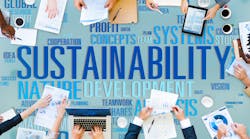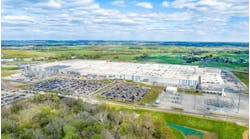Since 2008, Kohler has worked to reduce greenhouse gas (GHG) emissions and waste to landfill with a goal of reaching “Net Zero” (with offsets) by 2035. This has become a springboard for innovation throughout the company.
We use Life Cycle Inventory (LCI), a product modeling tool, to evaluate a product’s lifetime environmental impact. LCIs look at supplier operations, Kohler operations, consumer use and end-of-life.
These principles help us take a step back and evaluate the environmental impact of a product from raw material extraction through manufacturing, packaging, use and to its ultimate end via recycling, repurposing or disposal. Our recently released Highline 1.0 is the result of 10 years of performance evaluations, design tweaks and discovery. Kohler engineers discovered a way to more precisely target the flow of water into the bowl so that only one gallon of water is needed per flush. Relatively small design adjustments to the tank, bowl and trapway have reduced water use by 38% compared to a traditional 1.6 gallon per flush toilet.
We’ve also found opportunities to improve manufacturing sustainability in unexpected places.
In an LCI evaluation at our Reynosa, Mexico, facility, we discovered a way to reduce GHG emissions. In Reynosa, it’s common for daytime temperatures to reach 100 degrees Fahrenheit during the four-month warm season. When the facility’s electric cooling units were due for replacement, associates explored more sustainable options and learned the area has the world’s largest reservoir of natural gas.
The team seized the opportunity to replace electric air conditioners with natural gas cooling units. As a result, the Reynosa facility increased energy efficiency and is saving millions of pounds in GHG emissions annually, while also making the facility more comfortable for employees.
In another example, Kohler cast iron engineers saved 6,200 tons of iron from being melted each year. In production of one of our most popular bath tubs, molten iron is poured through “sprues” into the mold. Excess iron remains in the sprues, cools and solidifies. This excess iron is punched out to release the finished bathtub from the line. Our equipment required large sprues and, therefore, a large amount of extra iron, to function properly. The unused iron was eventually reused, but substantial energy was used in re-melting it.
Cast iron engineers upgraded to new equipment that could function with sprues 20 pounds smaller than the original. This saves 80 pounds of iron per bathtub. Overall, the upgrade reduced iron melting requirements by over 13%, energy use for the transfer of molten iron by 20 percent, and losses due to cracked bathtubs by nearly 50 percent.
These are just a few examples of how we’re making manufacturing changes that reduce our company’s environmental impact from product design to the end of the product’s useful life.
Rob Zimmerman is director of marketing, Projects, Specifications & Sustainability for Kohler Company.
ShopFloor is the blog of the National Association of Manufacturers (NAM).




